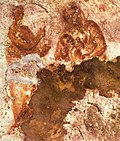File:Madonna catacomb.jpg

This file is from Wikimedia Commons (production) and may be used by other projects. The description on its file description page there is shown below.
Summary
| Virgin and Child with Balaam the Prophet | |
|---|---|
| Artist |
Unknown authorUnknown author |
| Title |
Virgin and Child with Balaam the Prophet label QS:Len,"Virgin and Child with Balaam the Prophet" |
| Description |
Image of the Virgin Mary, mother of Jesus, in the Catacomb of Priscilla in Rome. It depicts her nursing the Infant Jesus. This is earliest known image of Mary and the Infant Jesus[1] (independent of the Magi episode). The figure at the left appears to be the prophet Balaam pointing to a star (outside the frame).[2] The star is from Numbers 24:17. Alternatively, Isaiah (7:14) predicts the birth of Jesus from the Virgin Mary.[2][3][4] |
| Date |
late 2nd century date QS:P571,+150-00-00T00:00:00Z/7 |
| Medium |
fresco medium QS:P186,Q25631150 |
| Notes | The emphasis on the maternal love of Mary for the Child Jesus reflects the early Christian community's reverence for the Mother of God, and for its understanding of God's love for humankind in sending His only Son to earth to share in our humanity."[1] |
| Source/Photographer | adapted from the quoted page. |
| Other versions |
       |
- ↑ a b Byrne, Joseph. Out of the Depths...The Christian Catacombs of Ancient Rome: An Introduction. belmont.edu. "This Madonna and Child from the Catacomb of Priscilla is the oldest known representation of this most touching and human aspect of Christ's Incarnation."
- ↑ a b Lowrie, Walter (1901) Christian Art and Archaelogy, pp. 245−247 "It will be noticed that the man, who is clad in the philosopher's pallium, is pointing to a star. It is not perfectly clear what the picture represents, but the man is commonly taken to be a prophet foretelling the birth of Christ, and he is identified as Isaiah or as Balaam."
- ↑ Wilpert, Joseph , ed. (1903) Die Malereien der Katakomben Roms (Tafeln), p. plate 22 "Isaias predicts the birth of the Messiah from the Virgin"
- ↑ F. Vigouroux , ed. Dictionary of the Bible, 1 "An ancient monument in the Roman catacombs confirms the written tradition. In a sepulchral chamber in the cemetery of Priscilla, which M. de Rossi dates back to the confines of the apostolic age, Mary (fig. 102) is represented seated, her head half-covered by a short, transparent veil, and carrying in her arms the infant Jesus, who turns towards her. Standing beside the virgin mother, a man holds a rolled-up volume in one hand and points to a star with the other. In this young and austere figure, dressed as a philosopher, M. de Rossi recognizes Isaiah...This image, painted at the latest in the first half of the second century, is therefore an illustration of the oracle of Isaiah."
Licensing
|
This is a faithful photographic reproduction of a two-dimensional, public domain work of art. The work of art itself is in the public domain for the following reason:
The official position taken by the Wikimedia Foundation is that "faithful reproductions of two-dimensional public domain works of art are public domain".
This photographic reproduction is therefore also considered to be in the public domain in the United States. In other jurisdictions, re-use of this content may be restricted; see Reuse of PD-Art photographs for details. | |||||
File history
Click on a date/time to view the file as it appeared at that time.
| Date/Time | Thumbnail | Dimensions | User | Comment | |
|---|---|---|---|---|---|
| current | 16:14, 21 March 2025 |  | 796 × 939 (706 KB) | wikimediacommons>Jacqke | photo of same painting, higher resolution, tonality closer to original painting, from https://doi.org/10.11588/diglit.1339#0024 |
File usage
Metadata
This file contains additional information, probably added from the digital camera or scanner used to create or digitize it.
If the file has been modified from its original state, some details may not fully reflect the modified file.
| JPEG file comment | footer20201223 |
|---|
